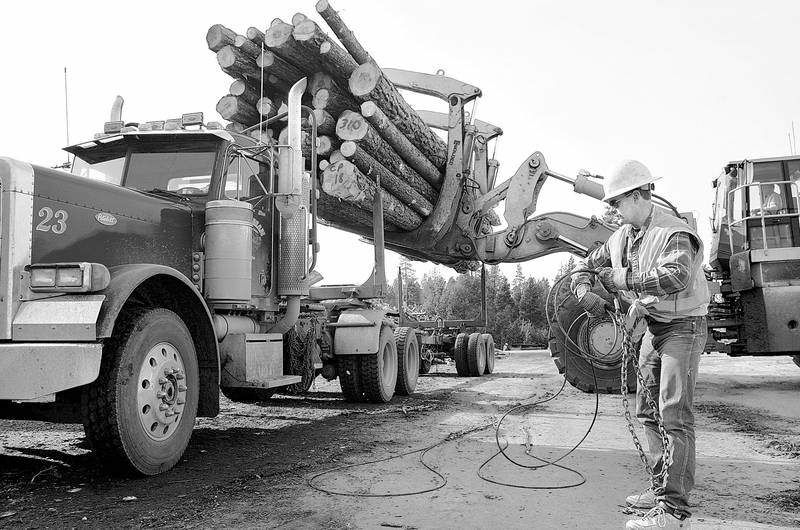After sitting idle, Gilchrist sawmill set to run again
Published 4:00 am Monday, January 14, 2008

- Log truck driver Steve Vickerman, 40, of Paisley, rolls up cable log wrappers, as Joe Varner, 56, of Crescent, drives a lifter while moving more than 50,000 pounds of logs off Vickerman’s truck, in the log yard at the Interfor Pacific mill in Gilchrist on Nov. 14. The mill has been closed for several weeks due to a slow timber market.
At the Interfor Pacific mill in Gilchrist, the machines that transform logs into lumber have sat idle for a month.
It isn’t a shortage of logs that stopped the mill from running. The yard is full of stacked logs, now covered in snow, said Greer Kelly, log supply coordinator for the mill.
Instead, the mill located south of the Deschutes County line has remained closed for the last couple of weeks due to a slow timber market stemming from the low demand for new houses across the country.
“The market’s so bad, prices have been dropping for lumber every month, and we can’t keep up,” Kelly said. “Basically, it’s just hard to move lumber right now.”
The sawmill, one of the few remaining in Central Oregon, usually shuts down for two weeks over the holidays for maintenance, he said. But this year, the start-up date has been pushed back multiple times. About a week ago, the company told loggers working on its projects to stop cutting trees, he said.
Work is scheduled to start up again today, as employees come back from the furlough to warm up the machines, plow the snow and start cutting lumber. But from there, Kelly said, the company will have to see if more changes in operations are going to be required.
“We’re just basically going to start up (today) and see how we’re going,” he said. “Hopefully everything works, and then we can get back into the steady flow.”
For a week, the mill won’t take any new logs. Employees will work on processing some of the logs already in the yard.
After that, Kelly said, the mill might have to be particular about which logs it will bring in to ensure that it doesn’t cost more money to generate the lumber than it ultimately sells for.
While the small pine logs that the sawmill usually handles used to be worth about $325 per thousand board feet, on Friday the price was down to $280.
With prices down because of a low demand for lumber, combined with costs associated with logging and requirements to cut smaller, less profitable trees, people throughout the timber industry are struggling, he said.
“It’s affecting the whole timber industry in the Northwest, and we’re not immune to it,” Kelly said.
Lumber prices are at levels that haven’t been seen since the 1980s, said Chuck Burley, a state representative from Bend and a regional representative with the American Forest Resource Council.
“With the housing market the way it is, it’s pretty tough right now for these guys,” Burley said.
It could take awhile for the industry to get through the slowdown, he said, and the timing will depend on what the national economy and housing market do.
But the mill’s managers want to get it up and running again, Kelly said.
“We’re really concerned about our employees,” he said. “We want to get our employees back to work and get everything back working in a steady, productive manner.”
And the flat housing market doesn’t just affect sawmills, he said, but it has repercussions for loggers, truck drivers and people who use the wood to make products like window frames for houses, for example.
“Everyone gets hurt on this stuff when there’s no demand,” he said.
Another local company feeling the effects is Prineville’s Ochoco Lumber Co., which depends on the Interfor mill to take its smaller trees, said John Morgan, resource manager with the company. Morgan said he had to stop cutting trees on the company’s timberlands.
“We can’t just keep our logger going, decking wood that we don’t have the market for,” he said.
And January, when loggers are usually able to cut on frozen ground to minimize disturbances to the soil, is an important month for cutting timber, he said. Starting in February, the snow cover can begin to break up, and in the Ochocos loggers can’t cut on wet ground. That means it could be June before the company can start delivering logs again, Morgan said.
And that affects people who are counting on the work and the income from logging and related industries.
“It’s a ripple effect,” Morgan said, “to us as landowners … to the workers, and on to truckers and the loggers and fuel people.”
But he said he understands Interfor’s situation: “If you can’t sell lumber, how can you keep running the mill?”
The lumber market doesn’t look like it’s going to pick up any time soon, Kelly said.
“Until people get back to buying houses, and they start building more, it’s going to be this way,” he said.






